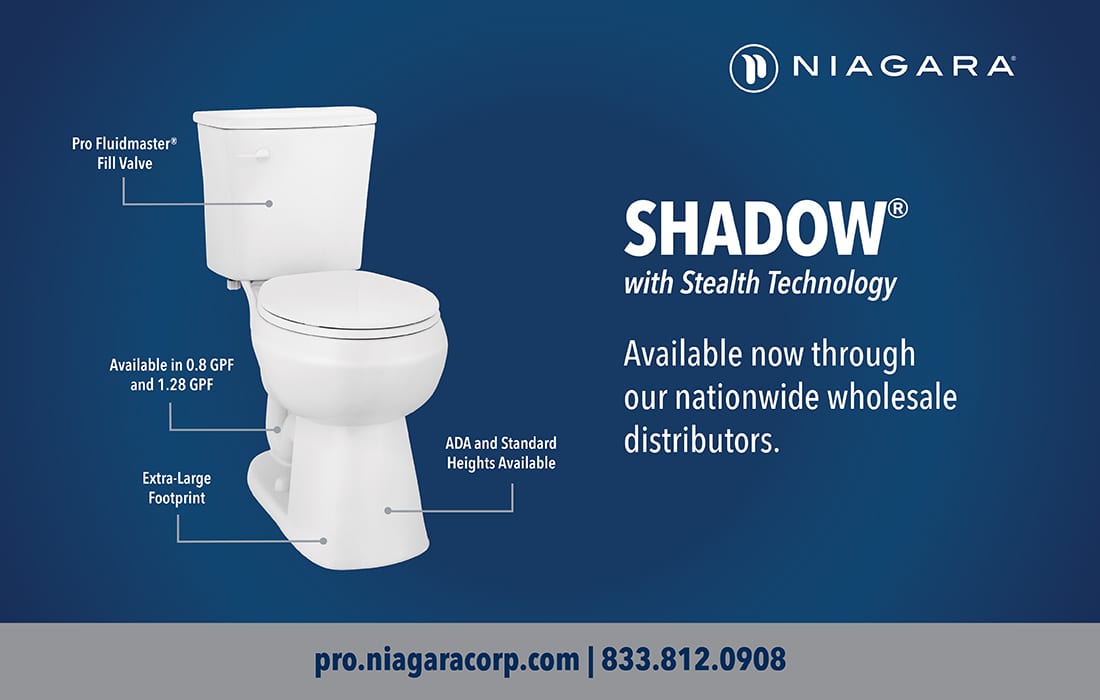RESIDENTIAL
DEMAND FOR CONSERVATION RISES
MYTH-BUSTING LOW-FLOW TOILETS.
By: Matt Vorhees
Xxxxxxxx
Whether you are a contractor, service plumber or supply house, rising water costs are affecting everyone. According to the EPA, over 25% of household water use comes from bathroom fixtures and leaks, and many older properties and single-family homes are still using old and outdated fixtures that are needing to be replaced every day. Additionally, the 2021 U.S. Municipal Water & Wastewater Utility Rate Index showed that the combined water and wastewater bill has increased by 43.2% since 2012 . In the past decade there have been record breaking droughts and we have seen an alarmingly fast depletion of water resources. It seems like every day there’s a new report coming out showing Lake Mead at record lows and it doesn’t look like the droughts will let off any time soon.
Home and property owners demand water-conservation
In January 2022, Niagara ran a survey to nearly 10,000 contractors, plumbers, and plumbing professionals across the nation to learn more about how industry professionals and their customers felt about water-conserving products. 70% of responders said that their clients think water-conservation is important. Additionally, Apartment List’s 2021 report shows that millennials account for over 50% of new mortgages and according to YPulse , 81% of millennials and elder gen Z are either interested in purchasing environmentally friendly products for their homes or already have.
It’s not a leap to say that home and property owners will want to install low-flow toilets, and it will be our job as industry professionals to help them find a model that best fits their property’s needs.

Study shows plumbers want low-flow toilets
In the study mentioned earlier, over 74% of plumbing industry professionals said that yes, they used high-efficiency toilets. When asked about the features or benefits their clients are interested in when shopping for a toilet, only 6% were interested in cost, and over 20% wanted to put low-flow and efficiency as a priority.
When you pair the data above with the fact that 40% of plumbers wanted to prioritize performance, it’s easy to understand that when looking for a low-flow toilet to used, you’re going to want to look for one that has extremely high-performance standards. If you purchase toilets with certifications like EPA’s WaterSense and MaP or MaP Premium, you’re going to be answering the needs of over 70% of your customers while getting the best of water-conservation and high-performance.
Common misconceptions about low-flow toilets
Regardless of the data, you will always have someone who are apprehensive to adopt water-conserving products for a few different reasons, but these misconceptions are exactly that — misconceptions.
• Poor Performance: The most obvious misconception about low-flow toilets is the perception that they do not perform well. This misconception is due to the very first low-flow toilets that came on to the market in the 90s. Since then technology and standards have had over 30 years to progress. Be sure to only carry MaP or MaP Premium certified models so that you can guarantee performance.
• Too expensive: The idea that water conserving toilets are more expensive than more traditional models is not completely unfounded, but given the logistical issues caused by the pandemic, all manufacturers have had to increase their costs on many products, including toilets. Additionally, the cost up front on a water-conserving model will pay for itself tenfold when home and property owners get a lower water bill back. Most water-conserving products end up providing a return on investment and then some in as little as a year — not something a traditional or higher-flow toilet can do.

Bonus tip: Most counties offer a rebate program if home or property owners replace their toilets with models that use 1.28 GPF or less. Check the EPA has a tool called the WaterSense Rebate Finder to help locate if a county offers a rebate for low-flow toilets, but you can also check your local county’s water provider website.
• Complicated installations: When surveyed, the responders said that the hardest part of installing a new toilet is removing the old one. Although a new toilet can’t help with that, respondents also said that attaching the tank was also a pretty standard headache. If you stock toilets that come pre-assembled you could be saving your customer’s time. Some pre-assembled models can be installed so quickly and easily they can be in and out of a job in under 20 minutes. Additionally you can use manufacturers who have helpful how tos or YouTube videos to help train up new employees or troubleshoot issues your customers might have mid-install.
At the end of the day, water conserving fixtures help the environment, but they help the bottom line for your customers allowing the product to be a premium offering on your truck or at a supply house.

Most counties offer a rebate program if home or property owners replace their toilets with models that use 1.28 GPF or less.
Whether you are a contractor, service plumber or supply house, rising water costs are affecting everyone. According to the EPA, over 25% of household water use comes from bathroom fixtures and leaks, and many older properties and single-family homes are still using old and outdated fixtures that are needing to be replaced every day. Additionally, the 2021 U.S. Municipal Water & Wastewater Utility Rate Index showed that the combined water and wastewater bill has increased by 43.2% since 2012 . In the past decade there have been record breaking droughts and we have seen an alarmingly fast depletion of water resources. It seems like every day there’s a new report coming out showing Lake Mead at record lows and it doesn’t look like the droughts will let off any time soon.
Matt Voorhees is Niagara’s Director of Wholesale. Photos and graphs courtesy of Niagara Corporation. Lead video courtesy of Anita Chavan / Creatas Video+ / Getty Images Plus





